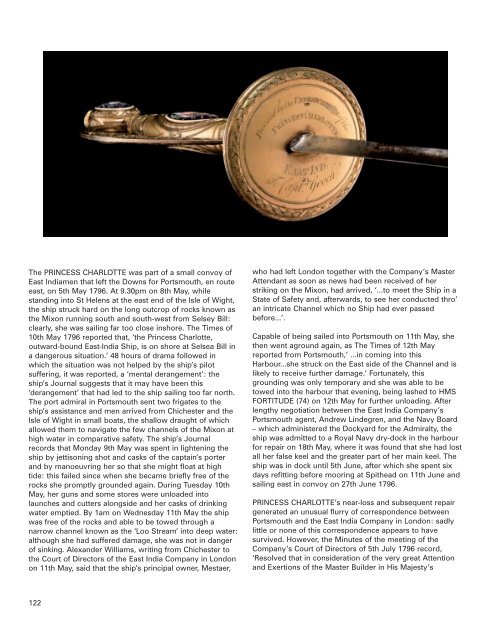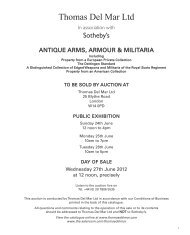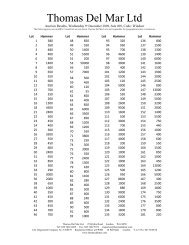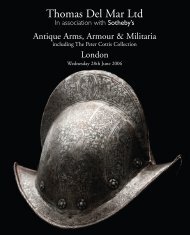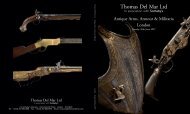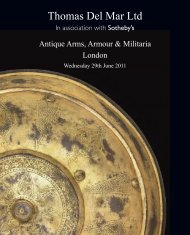antique arms, armour & militaria - Thomas Del Mar
antique arms, armour & militaria - Thomas Del Mar
antique arms, armour & militaria - Thomas Del Mar
You also want an ePaper? Increase the reach of your titles
YUMPU automatically turns print PDFs into web optimized ePapers that Google loves.
The PRINCESS CHARLOTTE was part of a small convoy of<br />
East Indiamen that left the Downs for Portsmouth, en route<br />
east, on 5th May 1796. At 9.30pm on 8th May, while<br />
standing into St Helens at the east end of the Isle of Wight,<br />
the ship struck hard on the long outcrop of rocks known as<br />
the Mixon running south and south-west from Selsey Bill:<br />
clearly, she was sailing far too close inshore. The Times of<br />
10th May 1796 reported that, ‘the Princess Charlotte,<br />
outward-bound East-India Ship, is on shore at Selsea Bill in<br />
a dangerous situation.’ 48 hours of drama followed in<br />
which the situation was not helped by the ship’s pilot<br />
suffering, it was reported, a ‘mental derangement’: the<br />
ship’s Journal suggests that it may have been this<br />
‘derangement’ that had led to the ship sailing too far north.<br />
The port admiral in Portsmouth sent two frigates to the<br />
ship’s assistance and men arrived from Chichester and the<br />
Isle of Wight in small boats, the shallow draught of which<br />
allowed them to navigate the few channels of the Mixon at<br />
high water in comparative safety. The ship’s Journal<br />
records that Monday 9th May was spent in lightening the<br />
ship by jettisoning shot and casks of the captain’s porter<br />
and by manoeuvring her so that she might float at high<br />
tide: this failed since when she became briefly free of the<br />
rocks she promptly grounded again. During Tuesday 10th<br />
May, her guns and some stores were unloaded into<br />
launches and cutters alongside and her casks of drinking<br />
water emptied. By 1am on Wednesday 11th May the ship<br />
was free of the rocks and able to be towed through a<br />
narrow channel known as the ‘Loo Stream’ into deep water:<br />
although she had suffered damage, she was not in danger<br />
of sinking. Alexander Williams, writing from Chichester to<br />
the Court of Directors of the East India Company in London<br />
on 11th May, said that the ship’s principal owner, Mestaer,<br />
122<br />
who had left London together with the Company’s Master<br />
Attendant as soon as news had been received of her<br />
striking on the Mixon, had arrived, ‘...to meet the Ship in a<br />
State of Safety and, afterwards, to see her conducted thro’<br />
an intricate Channel which no Ship had ever passed<br />
before...’.<br />
Capable of being sailed into Portsmouth on 11th May, she<br />
then went aground again, as The Times of 12th May<br />
reported from Portsmouth,’ ...in coming into this<br />
Harbour...she struck on the East side of the Channel and is<br />
likely to receive further damage.’ Fortunately, this<br />
grounding was only temporary and she was able to be<br />
towed into the harbour that evening, being lashed to HMS<br />
FORTITUDE (74) on 12th May for further unloading. After<br />
lengthy negotiation between the East India Company’s<br />
Portsmouth agent, Andrew Lindegren, and the Navy Board<br />
– which administered the Dockyard for the Admiralty, the<br />
ship was admitted to a Royal Navy dry-dock in the harbour<br />
for repair on 18th May, where it was found that she had lost<br />
all her false keel and the greater part of her main keel. The<br />
ship was in dock until 5th June, after which she spent six<br />
days refitting before mooring at Spithead on 11th June and<br />
sailing east in convoy on 27th June 1796.<br />
PRINCESS CHARLOTTE’s near-loss and subsequent repair<br />
generated an unusual flurry of correspondence between<br />
Portsmouth and the East India Company in London: sadly<br />
little or none of this correspondence appears to have<br />
survived. However, the Minutes of the meeting of the<br />
Company’s Court of Directors of 5th July 1796 record,<br />
‘Resolved that in consideration of the very great Attention<br />
and Exertions of the Master Builder in His Majesty’s


